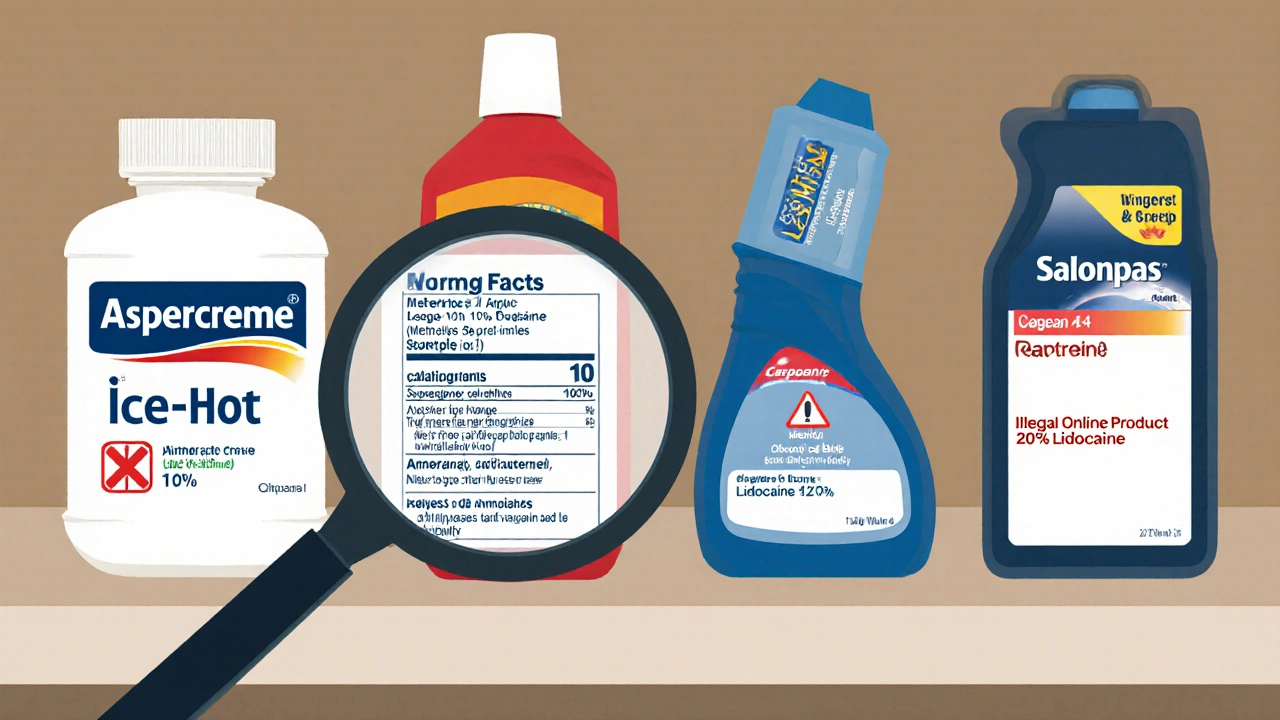What Are OTC Topical Pain Relievers?
OTC topical pain relievers are creams, gels, and patches you can buy without a prescription to ease muscle aches, joint pain, or arthritis discomfort. They work right where you apply them-no need to swallow a pill. Common brands include Aspercreme, Icy Hot, Capzasin, and Salonpas. These products contain active ingredients like menthol, capsaicin, methyl salicylate, or lidocaine that block pain signals or create a cooling/warming sensation to distract your nerves.
How Do They Work?
Each ingredient has a different way of working. Menthol triggers cold receptors in your skin, making your brain feel less pain. Capsaicin, the compound in hot peppers, depletes a chemical called substance P that sends pain signals. Methyl salicylate is related to aspirin and reduces inflammation locally. Lidocaine numbs the area by blocking nerve signals.
Unlike oral painkillers like ibuprofen or acetaminophen, topicals don’t flood your whole body with medicine. Only a small amount gets absorbed into your bloodstream. That’s why doctors often recommend them first for localized pain-like a sore knee or stiff shoulder-especially if you’re at risk for stomach bleeding, kidney issues, or high blood pressure from pills.
The Real Risks: Menthol Burns and Lidocaine Dangers
Just because it’s over-the-counter doesn’t mean it’s risk-free. In 2017, Health Canada confirmed a rare but serious side effect: skin burns from products containing menthol. These aren’t mild rashes-they’re actual chemical burns that can blister and scar. The risk is low, but it’s real. Most cases happen when people use menthol creams with heating pads, tight bandages, or on sensitive skin. One product, Aspercreme Heat Pain Relieving Gel, contains 10% menthol-enough to cause damage if misused.
Even worse are illegal products sold online. In July 2023, the FDA pulled six brands off the market-including DermaRoller Store and Bella’s Beauty Supply-for selling topical gels with up to 20% lidocaine. The legal limit is 4%. At those levels, lidocaine can enter your bloodstream and cause seizures, irregular heartbeat, or trouble breathing. These products were marketed for use before or after laser treatments, tattoos, or piercings. That’s a dangerous combo. Your skin is already compromised, and flooding it with high-dose numbing agents is asking for trouble.
Who Should Avoid These Products?
Some people shouldn’t use topical pain relievers at all. If you’re allergic to aspirin or have salicylate sensitivity, avoid methyl salicylate or diclofenac creams. If you’re on blood thinners like warfarin, talk to your doctor before using any salicylate-based product-even if it’s on your skin. Capsaicin can cause intense burning when first applied, especially if you have cuts, eczema, or sunburned skin. Never use it on broken skin.
People with diabetes or nerve damage should be extra careful. If you can’t feel pain in your feet or hands, you might not notice a burn developing. Same goes for older adults with thin skin or reduced sensation. A patch left on too long or a cream rubbed in too hard could cause damage without you realizing it.

Safe Usage Rules You Can’t Ignore
- Don’t apply to broken skin. Even a tiny cut or rash increases absorption and risk.
- Avoid heat. Never use a heating pad, hot water bottle, or electric blanket over the area. Heat makes ingredients absorb faster and increases burn risk.
- Wash your hands. After applying capsaicin or any cream, wash thoroughly. Accidentally rubbing your eye after touching capsaicin? That’s a medical emergency.
- Use gloves or applicators. Capsaicin products often come with a roll-on or glove. Use them. Your fingers will burn for hours if you don’t.
- Don’t cover it up. Don’t wrap the area tightly with plastic or bandages unless the label says it’s okay.
- Check the expiration date. Old creams lose effectiveness and can degrade into harmful substances.
How Long Until It Works?
Don’t expect instant results. Menthol and methyl salicylate give quick relief-usually within minutes. But capsaicin? That’s different. It can take 3 to 7 days of using it 3-4 times a day before you feel real improvement. And you have to keep using it. Stop too soon, and the pain comes back. Diclofenac gel also takes up to a week to show full effect.
Some people think, “If a little helps, more must be better.” That’s not true. Using too much, too often, or for too long can cause skin irritation, redness, or even tolerance-where the product stops working as well. Your body adapts. That’s why it’s important to follow the directions: usually 3-4 times daily, no more than 7 days in a row unless your doctor says otherwise.
Topical vs. Oral: What’s Safer?
Oral NSAIDs like ibuprofen or naproxen carry known risks: stomach ulcers (affecting 1-2% of regular users), kidney damage, and higher blood pressure. Long-term use can even raise your risk of heart attack or stroke. Topical versions avoid most of that because only a fraction of the drug enters your blood.
Harvard Health Publishing confirmed in 2024 that topical pain relievers are a safer option for people with kidney disease, high blood pressure, or a history of GI bleeding. But they’re not magic. They work best for surface-level pain-not deep joint pain or nerve pain like sciatica. For those, you might still need oral meds or other treatments.
What to Look for on the Label
Always read the Drug Facts panel. Check the active ingredients and their percentages. Menthol above 10%? That’s high. Lidocaine over 4%? That’s illegal. Look for warnings about burns, skin sensitivity, or avoiding heat. If the label doesn’t list active ingredients clearly, walk away.
Also check for the Natural Product Number (NPN) in Canada or the Drug Facts label in the U.S. These mean Health Canada or the FDA reviewed the product for safety and labeling. Products without these are often sold online or in convenience stores and may be unregulated.
When to See a Doctor
If your pain lasts more than 7 days despite using the cream or patch, it’s time to get checked. Topicals are for temporary relief, not long-term fixes. If you notice redness, blistering, or a burning sensation that doesn’t go away after washing, stop using it and call your doctor. If you feel dizzy, have trouble breathing, or your heart races after using a patch-even if you followed instructions-seek emergency care. That could be lidocaine poisoning.
Also, if you’re using multiple OTC products-like a pain cream plus a muscle rub plus a heating pad-you might be overdosing without knowing it. Talk to your pharmacist. They can help you avoid dangerous combinations.
Final Thoughts: Smart Use = Safe Relief
OTC topical pain relievers can be a smart, low-risk way to manage everyday aches. But they’re not harmless. The risks are real-especially with menthol and illegally concentrated lidocaine. The key is knowing what you’re using, reading the label like a detective, and never assuming “over-the-counter” means “safe for anything.” Use them as directed, avoid heat and broken skin, and don’t use them as a crutch for chronic pain. When in doubt, ask your pharmacist. They’re trained to catch these risks before they become problems.
Can I use OTC pain cream if I have diabetes?
People with diabetes should be cautious. Nerve damage can reduce your ability to feel pain or heat, so you might not notice a burn developing. Avoid using topical pain relievers on feet or areas with poor sensation. If you do use them, check your skin daily for redness or irritation. Always wash your hands after applying, and never combine with heating pads.
Is capsaicin safe for long-term use?
Yes, if used correctly. Capsaicin is safe for long-term use for osteoarthritis or nerve pain, but you must use it consistently-3 to 4 times daily. It takes up to a week to work, and stopping will make the pain return. The burning sensation fades over time. Always wear gloves or use a roll-on applicator to avoid transferring it to your eyes or mouth.
Can I use topical pain relievers with oral painkillers?
It’s usually safe, but check with your doctor or pharmacist first. Using a topical salicylate cream (like methyl salicylate) with oral aspirin or ibuprofen increases your total salicylate dose, which can raise your risk of side effects. Same goes for diclofenac gel plus oral NSAIDs. Your body doesn’t know if the drug came from a pill or a cream-it just sees the total amount.
Why do some products warn against use before laser treatments?
Laser treatments, microdermabrasion, and tattoos damage your skin’s outer layer. That makes it easier for chemicals like lidocaine to soak in deeply and enter your bloodstream. Products with high-dose lidocaine (over 4%) can cause serious side effects like seizures or heart rhythm problems. The FDA has cracked down on products marketed for this use because they’re dangerous and often illegal.
Are there any OTC topical pain relievers that are completely risk-free?
No product is completely risk-free. Even water can cause harm if misused. But properly used, approved OTC topicals like low-dose menthol, capsaicin, or lidocaine (under 4%) have a strong safety record. The biggest risks come from misuse-applying to broken skin, using heat, or buying unregulated products online. Stick to pharmacy-bought products with clear labels and follow the instructions exactly.








Skye Hamilton November 29, 2025
So basically if you use one of those menthol creams while watching Netflix with a heating pad you're basically doing a slow burn experiment on your own skin? Cool cool cool.
Madison Malone November 29, 2025
I’ve used capsaicin cream for my arthritis and yeah it burns like hell at first but after a few days it’s worth it. Just don’t touch your face after applying it. Learned that the hard way.
Geethu E December 1, 2025
In India we use mustard oil and garlic paste for joint pain. Works better than most creams and no weird chemicals. But yeah if you have diabetes or nerve damage don’t go wild with heat or strong stuff.
Jacob Hepworth-wain December 2, 2025
I always check the label for the active ingredient percentage now. Saw a guy on Reddit get a chemical burn from Aspercreme Heat and it scared me straight. Don't be that guy.
tom charlton December 3, 2025
The FDA’s crackdown on illicit lidocaine products is long overdue. These unregulated compounds are not only dangerous-they are predatory. Consumers must be vigilant and purchase only from licensed pharmacies with clearly labeled Drug Facts panels.
Graham Moyer-Stratton December 5, 2025
America needs to stop treating OTC like it’s candy. If you can’t read a label you shouldn’t be allowed near pain cream. Simple.
Michelle N Allen December 6, 2025
I used one of those patches for my back and it worked okay for a couple days but then I stopped because I forgot to wash my hands and rubbed my eye and wow that was a mess like a whole hour of crying and running water and my neighbor thought I was being attacked
Chris Kahanic December 7, 2025
I’ve been using Salonpas for my knee pain for over a year now. Never had an issue. I follow the rules: no heat, no broken skin, wash hands, and I only use it 3 times a day max. It’s not magic but it’s better than popping pills every day.
George Hook December 9, 2025
There’s a real gap in public awareness here. People assume that because something is sold at CVS or Walmart it’s automatically safe. That’s not how pharmacology works. The risk profile changes dramatically with dosage, application method, and individual physiology. Misuse is not negligence-it’s systemic ignorance.
Olivia Gracelynn Starsmith December 9, 2025
If you have diabetes or neuropathy just skip the creams entirely and talk to your doctor about physical therapy or TENS units. You’re not saving money by risking a burn you won’t even feel until it’s too late.
anant ram December 10, 2025
Always read the label! Always wash your hands! Always avoid heat! Always check the expiration date! Always use gloves with capsaicin! Always consult your pharmacist! Always avoid unregulated online products! Always be cautious! Always!
Craig Hartel December 12, 2025
I used to think topicals were just for lazy people who didn’t want to take pills. Then I got my knee surgery and my doc said to use the gel instead of NSAIDs. Best decision I made. No stomach issues, no kidney stress. Just a little cream and a lot less worry.